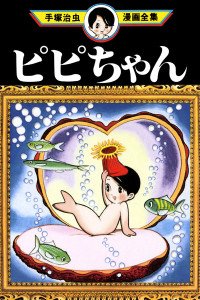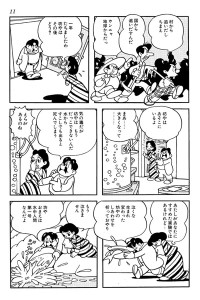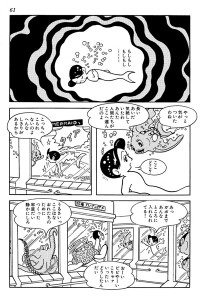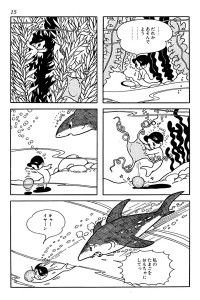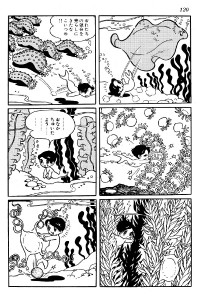Pippy (Manga)
also known as ピピちゃん (Pipi-chan)
| English Title: | Pippy |
| In English? | No |
| Japanese Title: | ピピちゃん Pipi-chan |
| Type: | Ongoing Serial |
| Original run: | 1951/12 – 1953/05 |
| Published in: | Funny Book もしろブック |
| Published by: | Shueisha |
| Volumes: | 1 MT-137 |
Tezuka’s undersea adventure, Pippy (1951-53) was originally serialized in Shuiesha’s Funny Book from December 1951 to May 1953, with a one-off Pippy side-story, “Pippy’s Adventure”, appearing in an Funny Book “Special Issue” in August 1952.
What it’s about
With human overpopulation quickly becoming an immense problem, Dr. Lehman decides the best idea is for humanity to live in the sea. After his idea is ridiculed, he decides to experiment on his newborn son, turning him into the world’s first mer-person. However, believing his son has died as a result of the experiment, Dr. Lehman and his wife commit his body to the sea, just as an angry mob – complete with pick axes and lawn rakes – shows up on their doorstep, demanding to know where the child is. The pair is convicted of murder and sentenced to prison.
Meanwhile in the ocean, Pippy is soon found and adopted by a mother sea turtle. Raised as one of her own, he and Gabo, the eldest of the other turtle children, have a series of mischievous adventures. On one of these, Pippy is almost fooled into believing he isn’t the only mer-person in the ocean. However after rescuing the “mermaid”, it turns out she’s a girl from the surface and she promptly thanks him and returns to land.
Tragically, the mother turtle is crushed to death by a submarine named the Nautilus, and Pippy and Gabo set off for the surface to seek justice. In order to blend in, Pippy disguises himself as a human by tying a large spoon to his waist and putting on a pair of pants, while Gabo replaces his turtle shell with a suitcase.
While on the surface, Pippy crosses paths with Mr. Ponkan, a friend of Dr. Lehman, who tells him of his father’s plan to have humans live in the sea. Then the pair briefly end up captives, in an aquarium as the star attractions – the “mermaid” and the rare bag turtle. However, after Pippy engineers their escape, a young lady named Hyacinth shows up, who, as luck would have it, she just happens to be the daughter of Captain Nemo, the owner of the Nautilus.
After returning to the ocean, Pippy goes on a quest to replace a giant clam named Nemo’s scarlet pearl. Along the way, he meets Engiline, a sentient car with a face, who helps him find the pearl. However when Nemo receives the replacement pearl, he becomes greedy, and tries to take Engiline as well – causing Pippy, Engiline and Gabo flee.
Then Pippy goes on a mission to find his lost parents. When he returns to his old family home, he is surprised to find manga artist Osamu Tezuka living there with his sister. After the initial shock of having a merboy show up their doorstep, the pair offer Pippy some clothes and a place to stay.
Meanwhile, the missing scarlet pearl turns up, and the White Heat Gang steal it, kidnap Hyacinth, and demand a ransom. Of course, after hearing about the situation, Pippy promptly rescues her and recovers the stolen pearl. In the end, Pippy gives the pearl to Mr. Ponkan, who uses it to free the Lehmans from prison and tearfully reunite Pippy with his human parents.
What you should know
Pippy (1951-53) is an interesting example of Tezuka retooling and re-purposing a good idea – a couple of times. Although the concept of the little merboy was originally intended as a story to be published as a stand-alone book, before the story could be completed, Tezuka decided to use it to round out another stand-alone book he was working on, Fossil Island (1951). One of his early experimental works, Fossil Island (1951) depicts the balance between “reality” and “manga” by having three travellers visit Fossil Island and each experience a separate set of dream sequences. Effectively, this meant that, despite being a feature-length book adventure, Fossil Island (1951) was more of a loosely stitched together anthology title. However, the problem with anthology titles is that you need more than one story. So, when push came to shove, Tezuka decided to retool the mermaid story he’d been working on, and include it as the final dream sequence.
Of course the Fossil Island (1951) dream sequence had only included a small part of the overall adventure story that Tezuka had originally intended – basically just what had been completed up to that point. However, he didn’t just return to his original plan and finish off the stand-alone book. Instead, given the success of his first foray into the serial adventure, Jungle Emperor (1950-54), Tezuka re-tooled Pippy once again and began publishing it as another serial adventure in Shuiesha’s Funny Book.
Although it is primarily considered a work geared towards children, Tezuka was not one to sanitize his stories. Much like his other children’s tales, such as the popular Unico (1976-79) for example, Pippy (1951-53) tackles some pretty sophisticated concepts. When one considers Tezuka’s juxta-positioning of the cute little merboy against a backdrop of such things as global overcrowding, human experimentation, child abandonment, and the death of a parent, it becomes clear that he is not pulling any punches with his young readership. Tezuka always gave his reader, even the very young ones, a lot of respect, believing difficult topics could and should be explored through manga, and Pippy (1951-53) is no exception to that.
Finally, it should be noted that Pippy (1951-53) shares something of a spiritual connection with another of Tezuka’s undersea adventures, Triton of the Sea (1969-71). Although the two are not directly related, Pippy (1951-53) set the stage with its undersea motifs, many of which make an appearance (or are more fully realized) in the later work – not the least of which is Pippy himself… Or should that be herself?

